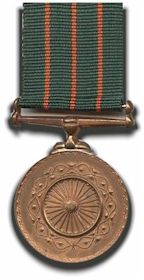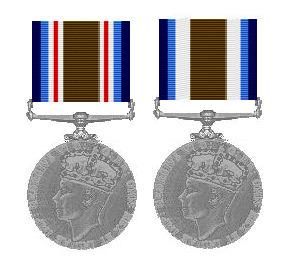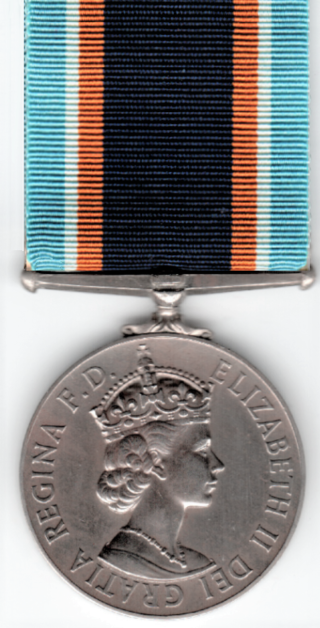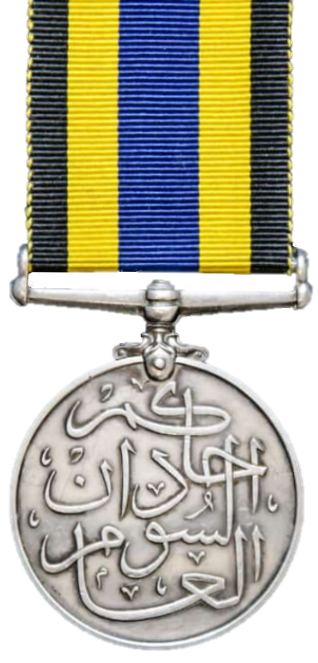
The national flag of India, colloquially called Tiraṅgā, is a horizontal rectangular tricolour flag, the colours being of India saffron, white and India green; with the Ashoka Chakra, a 24-spoke wheel, in navy blue at its centre. It was adopted in its present form during a meeting of the Constituent Assembly held on 22 July 1947, and it became the official flag of the Union of India on 15 August 1947. The flag was subsequently retained as that of the Republic of India. In India, the term "tricolour" almost always refers to the Indian national flag.

The Ashoka Chakra is India's highest peacetime military decoration awarded for valor, courageous action, or self-sacrifice away from the battlefield. It is the peacetime equivalent of the Param Vir Chakra (PVC) and is awarded for the "most conspicuous bravery or some daring or pre-eminent valour or self-sacrifice" other than in the face of the enemy. The decoration may be awarded either to military or civilian personnel.

The Shaurya Chakra is an Indian military decoration awarded for valour, courageous action or self-sacrifice while not engaged in direct action with the enemy. It may be awarded to civilians as well as military personnel, sometimes posthumously. It is third in order of precedence of peacetime gallantry awards and comes after the Ashoka Chakra and the Kirti Chakra. It precedes the Yudh Seva Medal.

The Kirti Chakra is an Indian military decoration awarded for valour, courageous action or self-sacrifice away from the field of battle. It may be awarded to civilians as well as military personnel, including posthumous awards. It is the peacetime equivalent of the Maha Vir Chakra. It is second in order of precedence of peacetime gallantry awards, comes after Ashoka Chakra and before Shaurya Chakra. Before 1967, the award was known as the Ashoka Chakra, Class II.

The Indian General Service Medal was a campaign medal approved on 1 January 1909, for issue to officers and men of the British and Indian armies. From 1919, it was also awarded to officers and men of the Royal Air Force, with the Waziristan 1925 clasp awarded solely to the RAF.

The King Edward VII Coronation Medal was a commemorative medal issued in 1902 to celebrate the coronation of King Edward VII and Queen Alexandra.

The King George V Coronation Medal was a commemorative medal instituted in 1911 to celebrate the coronation of King George V, that took place on 22 June 1911.

The China War Medal was issued by the British Government in 1843 to members of the British and Indian forces who took part in the First Opium War (1839–42). The medal was designed by William Wyon.

The India Service Medal 1939–1945 was a campaign medal of the Commonwealth. It was awarded to Indian Forces for three years of non-operational service in India during the Second World War.

The Canada General Service Medal was a campaign medal awarded by the Canadian Government to both Imperial and Canadian forces for duties related to the Fenian raids between 1866 and 1871. The medal was initially issued in 1899 and had to be applied for. The application period was later extended to 1907, then to 1928.

The Africa General Service Medal, established in 1902, was a campaign medal of the United Kingdom. It was awarded for minor campaigns that took place in tropical Africa between 1900 and 1956, with a total of forty five clasps issued. The medal is never seen without a clasp and some are very rare. Most medals were granted to British Colonial Auxiliary Forces units, including the King's African Rifles and the West African Frontier Force. The only campaigns where European personnel were present in any numbers were the various Somaliland campaigns,, and in Kenya.

The Ashanti Medal was sanctioned in October 1901 and was the first campaign medal authorised by Edward VII. This medal was created for those troops engaged in the Third Ashanti Expedition, also known as the War of the Golden Stool. This expedition lasted from March – December 1900, with the final outcome that the Ashanti maintained its de facto independence. Ashanti was made a Protectorate of the British Empire, but they ruled themselves with little reference to the colonial power.

The Ceylon Police Medal was awarded to police officers of the Ceylon Police Force, with two versions: for gallantry and for meritorious service. The number of medals for meritorious service was limited to a maximum of ten a year.

The Ceylon Police Long Service Medal was awarded to police officers in Ceylon of and below the rank of Chief Inspector for completing 18 years of unblemished service. Bars for 25 and 30 years service were also awarded.

The Burma Gallantry Medal (BGM) was a military decoration awarded for acts of gallantry, in both war and peace, by Governor's commissioned officers, non-commissioned Officers and other ranks of the British Burmese military. These included its Army, Frontier Force, Military Police, Royal Naval Volunteer Reserve and Auxiliary Air Force. Clasps, attached to the ribbon, could be awarded to mark further awards of the medal.

The Pakistan Medal was established by King George VI in 1949 as a commemorative medal. The medal commemorates service during the period just before and after the creation of the independent Dominion of Pakistan on 14 August 1947. Most recipients were members of the armed forces of Pakistan, including attached British personnel.

H.M. Coastguard Long Service and Good Conduct Medal is a long service medal awarded by the United Kingdom. Awarded for twenty years full or part-time service, with members of His Majesty's Coastguard, Coastguard Rescue Service, Isle of Man Coastguard and auxiliary coastguards eligible.

The Sudan Defence Force General Service Medal was a campaign medal instituted in 1933 to reward service in minor operations within the Anglo-Egyptian Sudan. It was last awarded for service in 1941.
The 25th Independence Anniversary Medal was issued to commemorate the historic occasion of 25 years of the independence of India.
The 50th Independence Anniversary Medal was issued to commemorate the historic occasion of 50 years of the independence of India. and is authorised for all Armed Forces personnel borne on strength as on 15 August 1997.



















